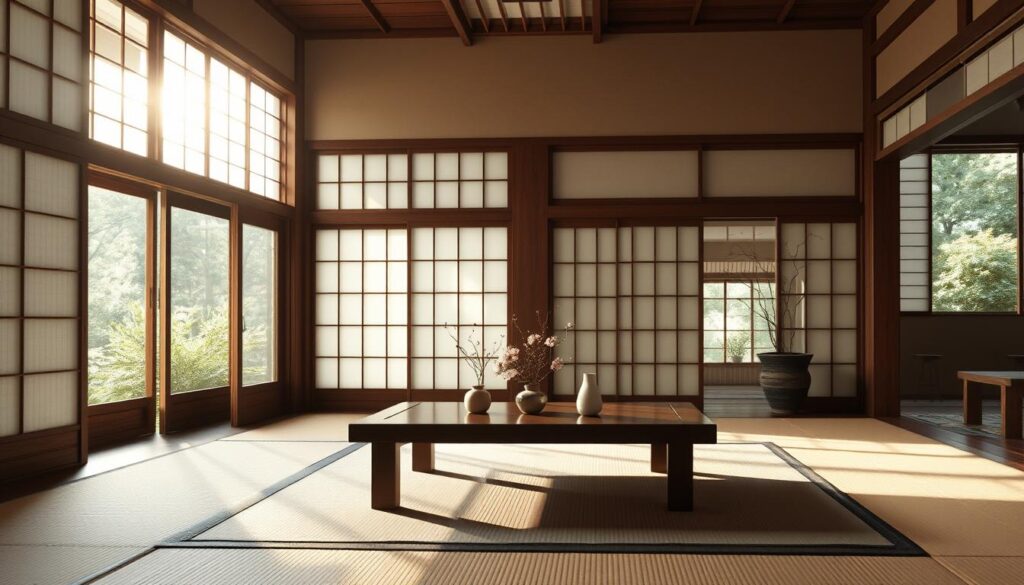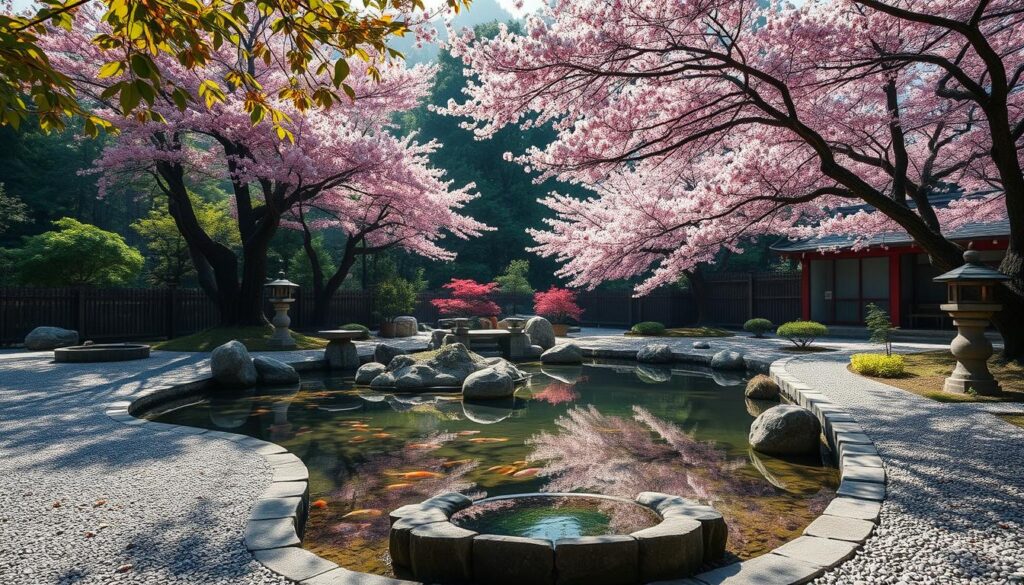“Simplicity is the ultimate sophistication.” – Leonardo da Vinci’s words perfectly sum up Japanese interior design. In today’s world, we seek calm in the minimalist beauty of Japanese style. It turns our homes into peaceful places that calm our minds and uplift our spirits.
The Japanese design philosophy is steeped in tradition yet modern. It values natural materials, balance, and the beauty of imperfection. This approach creates a unique and harmonious living space.
Key Takeaways
- Embrace the minimalist philosophy of “less is more” to create a serene and harmonious living space.
- Incorporate natural materials like light-colored wood, bamboo, and stone to connect with the tranquility of nature.
- Optimize natural light and strategically place traditional Japanese furnishings to cultivate a Zen-like atmosphere.
- Declutter and utilize minimalist storage solutions to maintain a sense of balance and simplicity.
- Explore the rich history and cultural significance of Japanese design to infuse your home with authenticity and meaning.
Understanding the Philosophy Behind Japanese Interior Design
To truly appreciate Japanese interior design, we must explore its deep philosophical roots. At its core is wabi-sabi, which values the beauty of imperfection and the fleeting nature of life. This philosophy brings a sense of calm and authenticity to spaces.
The Principles of Wabi-Sabi
The wabi-sabi philosophy is more than a design style; it’s a way of life. It celebrates simplicity, minimalism, and the beauty of natural flaws. It teaches us to see beauty in the imperfect and the impermanent, challenging Western ideals of perfection.
Shinto Influence in Design
Shinto beliefs also shape Japanese interior design, seeing spirits in all things. This belief in the natural world and the divine in everyday objects is reflected in the use of natural materials and the blending of indoor and outdoor spaces.
Balance and Harmony Concepts
Balance and harmony are key in Japanese design, aiming to create calm and clear spaces. The principle of datsuzoku shows the importance of mindfulness and intentionality in design.
These deep philosophical roots make Japanese interiors unique. They combine simplicity, natural elements, and functionality to create stunning and meaningful spaces.
Essential Elements of Modern Japanese Style Decor
Modern Japanese decor is all about simplicity. It celebrates nature and living in harmony with it. This style is deeply rooted in Shinto and wabi-sabi philosophies, making it unique and captivating.
Japanese interiors use simple materials like wood and stone. These materials add warmth and show the beauty of imperfection.
These spaces have a calm color scheme and lots of natural light. They are clean and have many plants, connecting indoors to outdoors. Tatami mats are also key, adding comfort and style.
Japanese furniture is simple yet functional. It’s made with care and has a low profile, fitting well in these spaces. Bathrooms are special, with big bathtubs and natural elements, bringing in a garden view.
Modern Japanese decor is all about simplicity and nature. It creates a peaceful and beautiful living space that fits today’s style.
| Key Elements of Modern Japanese Style Decor | Description |
|---|---|
| Minimalism | The philosophy of “less is more” is central to Japanese style houses. |
| Natural Materials | Japanese contemporary houses extensively use wood, stone, and paper in their design. Natural organic decor, such as wood, bamboo, and stone, is commonly used in Japanese interior decoration. |
| Color Palette | Neutral color palettes including shades of white, beige, and light brown are often employed in Japanese interior design. |
| Indoor-Outdoor Integration | Modern Japanese interior design emphasizes the seamless integration of indoor and outdoor spaces. |
| Functional Elements | Japanese decor includes functional elements like tatami mats, shoji screens, and futons. |
| Open Spaces | Open spaces are favored in modern Japanese interior design. |
| Natural Aesthetic | Traditional Japanese plants like Bonsai trees are commonly featured in Japanese interior design. Tatami mats, hand-woven straw mats, are used in Japanese houses for flooring. Ofuro, large bathtubs made of natural Hinoki materials of about 4.5 feet in diameter, are significant in Japanese interior design. |
| Low-Height Furniture | Modern Japanese interior design typically incorporates low-height furniture design. |
By using these key elements, we can make living spaces that are calm and beautiful. They reflect the timeless beauty of Japanese design.
“The essence of Japanese style is an intuitive understanding of the natural world and a quiet appreciation for simplicity.”
Natural Materials and Textures in Japanese Decor
In Japanese interior design, natural materials are key. The design philosophy values a deep connection to nature. This is seen in the materials used in homes. Traditional woods, bamboo, and rattan are at the heart of the Japanese aesthetic.
Types of Traditional Woods
Japanese woodworking is an art form with ancient techniques. Woods like cypress, cedar, and oak are common. They add warmth and an earthy feel to homes.
Bamboo and Rattan Applications
Bamboo and rattan are big in Japanese decor. They’re used for everything from room dividers to storage. Their flexibility and strength make them perfect for unique design pieces.
Stone and Paper Elements
Stone and paper are also key in Japanese design. River stones and weathered pebbles add a natural touch. Washi paper, used for shoji screens and lanterns, brings warmth and light.
Using natural materials in decor is more than just style. It shows respect for nature in Japanese design. These elements help create peaceful, harmonious spaces that connect us to nature.
| Natural Material | Applications in Japanese Decor |
|---|---|
| Wood | Furniture, architectural features, decorative accents |
| Bamboo | Room dividers, storage pieces, decorative elements |
| Rattan | Furniture, lighting, decorative accents |
| Stone | Garden elements, decorative accents |
| Washi Paper | Shoji screens, lanterns, wall art |
The Art of Minimalism in Japanese Spaces
Minimalism is key in Japanese design, thanks to Marie Kondo and her decluttering ideas. It means everything has a purpose and a place, making spaces balanced and peaceful. This philosophy also guides color choices, material use, and room layouts.
Japanese minimalism aims to create calm, clutter-free areas for mental clarity and relaxation. These spaces feature clean lines, natural materials, and focus on function. Furniture is simple and does more than one thing, making the most of small spaces. Glass panels and Shoji screens also bring in natural light, adding to the calmness.
Designers like Keiji Ashizawa lead in Japanese minimalism. They use sliding doors and walls to make spaces flexible and open. Following these principles, homeowners can make their homes peaceful, timeless, and eco-friendly.

“Minimalism is not a lack of something. It’s simply the perfect amount of something.” – Lindy Emchencich
| Key Elements of Japanese Minimalist Design | Benefits of Japanese Minimalist Design |
|---|---|
|
|
By embracing Japanese minimalism, homeowners can create peaceful, timeless, and eco-friendly homes.
Japanese Room Dividers and Sliding Doors
Japanese-inspired interior design is all about iconic elements like شاشات شوجي (Shoji screens) and sliding doors. These traditional partitions are not just useful. They also bring elegant minimalism to any room.
Shoji Screens Design
Shoji screens are famous for their rice paper panels and wooden frames. They let soft light through while keeping things private. This creates a calm and peaceful vibe.
These screens are great for changing up your space. They’re perfect for modern homes that need to be flexible.
Modern Adaptations of Traditional Partitions
Today, Shoji screens are still loved, but modern room dividers and sliding doors are also popular. They have clean designs and use materials like frosted glass for a modern look. You can even make your own Shoji screens to match your style.
These screens are seen as art pieces. They’re not just for dividing spaces. They add elegance and create a peaceful feel.
Adding Japanese elegance to your home means using things like rice paper screens and natural wood. It’s about creating a calm and peaceful space. These partitions help control light and space, making the room feel balanced and harmonious.
“Shoji screens allow natural light to filter through while maintaining privacy, creating a serene and tranquil atmosphere in a room.”
Looking to make your home more flexible or stylish? شاشات شوجي (Shoji screens) and sliding doors are great choices.
- Recent Pinterest searches show a growing interest in Japanese room dividers.
- Versatile bamboo and calligraphy-inspired room dividers are popular options for creating flexible and stylish spaces.
- Vintage and antique room dividers cater to those seeking unique and one-of-a-kind pieces.
By adding these Japanese elements, you can turn your home into a peaceful oasis. It will show off the beauty and simplicity of traditional Japanese design.
Traditional Japanese Furniture and Layouts
Japanese-inspired home decor focuses on clean lines and minimalist designs. It also emphasizes blending with nature. This philosophy is seen in traditional Japanese furniture, loved by design fans worldwide.
Japanese furniture is known for its low-profile designs. These designs make rooms feel open and peaceful. Pieces often serve more than one purpose, fitting well in small spaces while looking serene.
Japanese rooms are laid out to use space wisely. They have open floor plans and modular designs. This allows for easy changes in how the space is used.
At the center of Japanese furniture are tatami mats. They are the base for tables, floor cushions, and futon beds. Materials like fine woods, bamboo, and rice straw are key. They help create a calm and grounded feel.
| Traditional Japanese Furniture | Key Features |
|---|---|
| Tatami Mats | Natural woven mats that serve as flooring and seating |
| Low Tables | Minimalist, multipurpose tables designed for floor-level seating |
| Floor Cushions | Comfortable seating options that complement the low-profile aesthetic |
| Japanese Futon Beds | Versatile bedding that can be folded and stored when not in use |
Traditional Japanese furniture is known for its detail and natural elements. This timeless look still inspires today. It’s a favorite for those wanting a peaceful and balanced home.
Incorporating Japanese Style Lighting Solutions
Lighting is key in Japanese design, seen as an art form. Natural light is great, but sometimes it’s not enough. This is when we need extra lighting. The right lighting can make a space feel special and look beautiful.
Paper Lanterns and Their Placement
Paper lanterns, or chochin, add a soft glow to spaces. They are placed carefully to create a welcoming atmosphere. Wall sconces and washers are good for hallways, and ceiling lights with wood and clean lines fit well with the design.
Natural Light Optimization
In Japanese design, light and shadow play a big role, called “komorebi.” Big windows and few curtains let in lots of natural light. This makes spaces calm and lively. Unobtrusive lighting is best for living rooms, adding to the calm feel.
Japanese design loves natural materials like wood and paper. This creates harmony and balance. Japandi style, mixing Japanese and Scandinavian, uses natural materials like paper, wood, and bamboo. It aims for a soft, calming light that avoids clutter.
Using Japanese-inspired lighting can make homes peaceful and balanced. The soft light from paper lanterns or natural light can enhance any room’s Japanese feel.
Japanese Gardens and Indoor Plants
Japanese design deeply values nature, seen in both outdoor gardens and indoor spaces. It aims to bring peace and calm through plants. Rooms often feature plants like Kentia palms and fiddle leaf fig trees.
Natural light is key, making plants like wild banana and elephant-ear popular. Plant pots in natural textures add to the natural look of Japanese decor.
Decorating near the ground makes rooms feel bigger. Small plants like schefflera or ant plants work well for this. The Japanese style favors Minimalism, making plants stand out.
Outdoor spaces can also show Japanese style with plants like umbrella bamboo. This creates peaceful areas outside.
Wabi-sabi celebrates natural beauty and simplicity. Japandi design combines Japanese and Scandinavian styles, using plants like Cast Iron Plant and Succulents.

“The art of arranging flowers is about achieving a harmonious relationship between flowers, containers, and settings.”
By choosing plants wisely and following Japanese design principles, we can make our homes peaceful. These spaces nourish our senses and calm our souls.
Color Palettes in Japanese Style Decor
In Japanese-inspired interior design, the color palette is key. It captures the calm and natural beauty of Japan. The Japandi color palette includes neutral tones, earthy hues, and green from nature. Shades like beige, gray, brown, and green are used.
These colors, such as whites, browns, blacks, greys, and beiges, bring relaxation and tranquility. They are found in both Japanese and Scandinavian design. The aim is to create a peaceful space that values minimalism, nature, and comfort.
Traditional Color Combinations
Black and white is a classic choice in Japanese design, creating a calm room. Earthy tones like beige, brown, and grey also add to the serenity. Blue and white evoke Japan’s ceramics, while green and brown bring the outdoors in.
The red and black combo is bold, often seen in temples.
Modern Interpretations
Modern Japanese color palettes may include muted pastels or bold accents. The Japandi Color Palette can be used in many room elements, like furniture and decor. Backdrop offers eco-friendly, low-odor paints for a calming Japandi interior.
| Traditional Japanese Colors | Symbolism and Usage |
|---|---|
| Deep Blue | Extensively used in dyeing fabrics |
| Red | Symbolizes good fortune and happiness |
| White | Represents purity and cleanliness in Japanese culture |
| Yellow | Reflects nature, youth, and vitality |
| Gold | Associated with wealth, strength, and warmth |
| Silver | Symbolizes grace, sophistication, and elegance |
| Black | Serves as an accent color in traditional Japanese aesthetics |
The Japanese aesthetic values harmony, respect, and tranquility. These values are seen in their color palette. By using these timeless colors and modern twists, you can make your space serene and harmonious.
Japanese Decorative Accessories and Art
In Japanese interior design, decorative items and art are key. They add beauty and meaning without making the space feel crowded. Items like ikebana and calligraphy scrolls are chosen for their beauty and cultural significance.
Natural materials like bamboo, wood, and paper are common in Japanese decor. In fact, 70% of the items in the collection are made from these sustainable materials. Ceramic Lucky Cats are a big part, making up 25% of the decorative items. Traditional textiles like futon and tatami mats also play a role, making up 15% of the accessories.
The Japanese art collection is diverse, from playful Kawaii pieces to calm calligraphy-inspired art. 10% of the art pieces are inspired by Kawaii aesthetics, showing Japan’s fun side. On the other hand, 10% of the art collection features traditional Japanese calligraphy, a timeless art form.
Decorative items in Japanese-inspired spaces often reflect Japan’s rich culture. Shoji screens, a staple in Japanese house decor, are featured in 30% of the offered ceiling decorations. Oirans, representing traditional courtesans, make up 5% of the Japanese-themed doll collection available. These pieces add authenticity and storytelling to any space inspired by Japan.
Japanese design is gaining popularity worldwide. Using decorative accessories and art that reflect wabi-sabi and Shinto principles is key. This creates spaces that feel peaceful, balanced, and connected to nature.
“Every object in a Japanese room, even the most mundane, gives off a flare and a shimmer, a light-filled and concentrated radiance.”
– Junichiro Tanizaki, “In Praise of Shadows”
Conclusion
The beauty of Japanese interior design is in its ability to create calm, functional, and beautiful spaces. It uses minimalism, natural materials, and careful design. This makes our homes peaceful places that bring us peace and harmony.
This style of decor is becoming more popular today. Our wish for sustainable, peaceful homes is growing.
Japanese decor uses sliding doors, big windows, and wood furniture. It also includes wind chimes, Kumiko lamps, and washi paper art. These elements make our homes look good and feel good.
By using soft lights, tatami mats, and simple furniture, we can make spaces that feel calm and good for our health.
As we look for ways to live more mindfully, Japanese design will keep inspiring us. It helps us make our homes peaceful, zen-like spaces. These spaces support a sustainable, Japanese interior design, zen living spaces, sustainable decor.
FAQ
What are the key principles of Japanese interior design?
Japanese interior design values wabi-sabi, which loves imperfection and change. It also respects Shinto, seeing spirits in everything. Balance, harmony, simplicity, and a bond with nature are key.
How does minimalism influence Japanese style decor?
Minimalism is central to Japanese design. It means cleaning up, making sure everything has a purpose, and finding balance. This approach affects color, furniture, and room layout, aiming for calm and clarity.
What are the common materials used in Japanese-inspired decor?
Japanese design often uses natural materials like light wood, bamboo, rattan, stone, and paper. These are found in furniture and decorations, showing Japan’s love for sustainability and natural materials.
How do Japanese-style room dividers and sliding doors contribute to the design?
Shoji screens, made of paper and wood, are key. They save space and let light in, making rooms flexible. They help create a peaceful, balanced space.
What are the key considerations for Japanese-inspired furniture and layout?
Japanese furniture is low and simple, with clean lines. It includes tatami mats, low tables, and cushions. The layout is open and space-efficient, showing Japan’s smart living.
How do Japanese-style gardens and indoor plants enhance the design?
Japanese design brings nature in with plants and gardens. Bonsai trees, orchids, and bamboo are favorites. Indoor gardens follow ikebana, blending with nature for harmony.
What are the typical color palettes used in Japanese-inspired decor?
Japanese decor often uses neutral colors like whites, beiges, and soft greys. Wood tones add warmth. These colors aim for a calm, natural feel.
How are decorative elements integrated into Japanese-style spaces?
Decor in Japanese design is chosen with care and shown sparingly. Items like ikebana, calligraphy, and ceramics are picked for their beauty and meaning. They add to the space without cluttering it.




